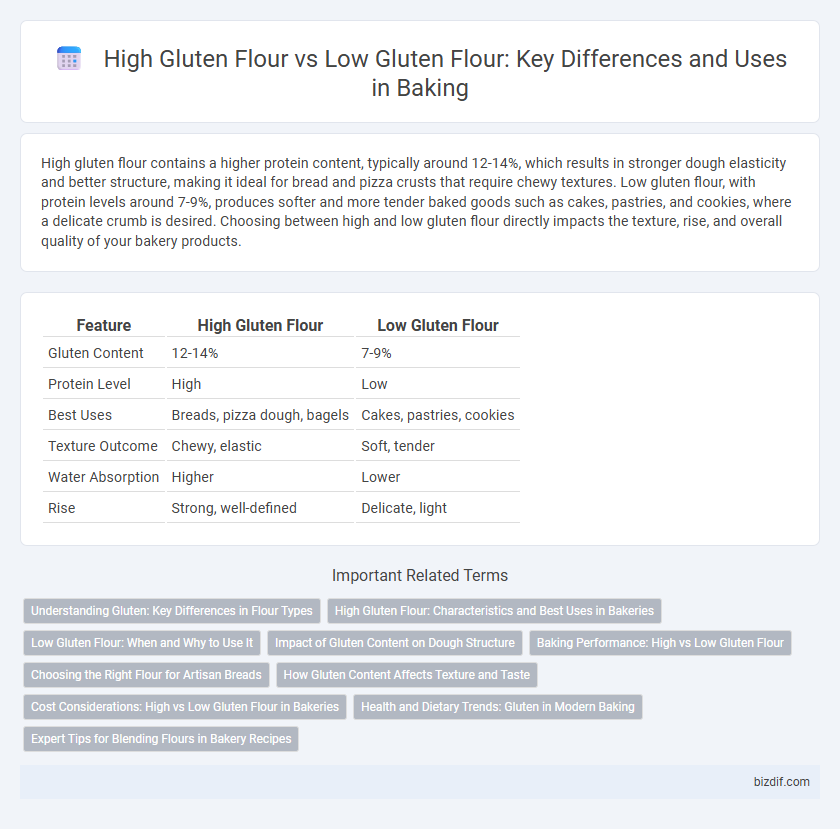High gluten flour contains a higher protein content, typically around 12-14%, which results in stronger dough elasticity and better structure, making it ideal for bread and pizza crusts that require chewy textures. Low gluten flour, with protein levels around 7-9%, produces softer and more tender baked goods such as cakes, pastries, and cookies, where a delicate crumb is desired. Choosing between high and low gluten flour directly impacts the texture, rise, and overall quality of your bakery products.
Table of Comparison
| Feature | High Gluten Flour | Low Gluten Flour |
|---|---|---|
| Gluten Content | 12-14% | 7-9% |
| Protein Level | High | Low |
| Best Uses | Breads, pizza dough, bagels | Cakes, pastries, cookies |
| Texture Outcome | Chewy, elastic | Soft, tender |
| Water Absorption | Higher | Lower |
| Rise | Strong, well-defined | Delicate, light |
Understanding Gluten: Key Differences in Flour Types
High gluten flour contains 12-14% protein, making it ideal for chewy bread and pizza dough due to its strong gluten network formation. Low gluten flour has around 8-10% protein, suited for tender baked goods like cakes and pastries where a delicate texture is desired. Understanding the protein content and gluten strength in these flours helps bakers choose the right type for specific recipes and desired crumb structure.
High Gluten Flour: Characteristics and Best Uses in Bakeries
High gluten flour contains 13-14.5% protein, providing strong gluten networks that create chewy, elastic textures ideal for artisan breads, pizza dough, and bagels. Its superior elasticity and gas retention improve dough rise and structure, resulting in chewy crusts and airy crumb. Bakers favor high gluten flour for products requiring enhanced dough strength and volume.
Low Gluten Flour: When and Why to Use It
Low gluten flour, typically containing 8-10% protein, is ideal for delicate baked goods like cakes, pastries, and cookies where a tender, soft crumb is desired. Its lower protein content prevents excessive gluten development, resulting in a finer texture and less chewiness compared to high gluten flour. Using low gluten flour enhances moisture retention and crumb tenderness, making it perfect for recipes that require a light, airy structure.
Impact of Gluten Content on Dough Structure
High gluten flour contains 12-14% protein, creating strong, elastic dough ideal for bread and pizza crusts that require a chewy texture and good rise. Low gluten flour, with 7-9% protein, produces softer, more tender doughs suited for cakes, pastries, and delicate baked goods where a crumbly or tender texture is desired. The gluten content directly influences dough strength, elasticity, and gas retention, which determine the final product's structure and texture.
Baking Performance: High vs Low Gluten Flour
High gluten flour, containing 12-14% protein, enhances dough elasticity and structure, making it ideal for bread and yeast-based baked goods requiring strong gluten networks. Low gluten flour, with 8-10% protein, produces tender, crumbly textures suited for cakes, pastries, and delicate baked items where minimal gluten development is desired. The varying protein content directly impacts water absorption, dough rise, and final product texture, optimizing baking performance based on flour choice.
Choosing the Right Flour for Artisan Breads
High gluten flour contains 12-14% protein, providing the strong gluten network essential for chewy, elastic artisan bread crusts and open crumb structures. Low gluten flour, with 8-10% protein, yields tender, crumbly textures ideal for cakes and pastries but lacks the strength for traditional artisan bread rise and chew. Selecting high gluten flour ensures optimal dough elasticity and gas retention, critical for achieving the desired texture and volume in handcrafted artisan breads.
How Gluten Content Affects Texture and Taste
High gluten flour, containing 12-14% protein, provides strong elasticity and chewiness, ideal for breads and pizza crusts with a firm texture and rich taste. Low gluten flour, with 7-9% protein, offers a tender crumb and softer texture, perfect for pastries and cakes with a delicate, subtle flavor. The gluten content directly influences dough structure, rise, and mouthfeel, shaping the final product's texture and taste profile.
Cost Considerations: High vs Low Gluten Flour in Bakeries
High gluten flour typically costs more than low gluten flour due to its protein content, which enhances dough elasticity and is essential for bread and pizza crust applications. Low gluten flour, often used for cakes and pastries, is more affordable but less suitable for products requiring strong gluten structure. Bakeries must balance ingredient costs with product quality and texture to optimize profitability based on the end product.
Health and Dietary Trends: Gluten in Modern Baking
High gluten flour, containing 12-14% protein, provides strong elasticity ideal for bread and pizza dough, while low gluten flour with 7-9% protein suits cakes and pastries requiring a tender crumb. Modern health trends emphasize gluten-free and low-gluten diets, prompting bakers to explore alternative flours and blends for digestive health and reduced gluten sensitivity. Consumers increasingly seek balanced options that maintain texture and flavor without compromising dietary restrictions related to gluten intolerance or celiac disease.
Expert Tips for Blending Flours in Bakery Recipes
High gluten flour contains 13-14% protein, providing strong gluten networks perfect for chewy breads like bagels and artisan loaves, while low gluten flour with 8-9% protein is ideal for tender cakes and pastries. Experts recommend blending high and low gluten flours in specific ratios to achieve balanced texture and structure, such as mixing 50% high gluten with 50% low gluten for enriched breads. Adjusting flour blends based on hydration and fermentation time enhances dough elasticity and crumb softness, optimizing bakery recipe results.
High gluten flour vs Low gluten flour Infographic

 bizdif.com
bizdif.com